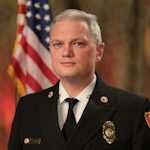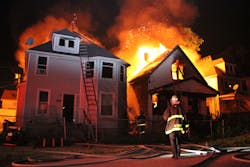Most structure fires to which we respond are single-family homes. In fact, between 2011 and 2015, single-family residential fires accounted for almost 73 percent of all reported structure fires, 93 percent of civilian structure fire deaths, 87 percent of the civilian structure fire injuries, and over 68 percent of direct structure fire property loss (Ahrens, 2017).
Based on a complexity-measurement system identified in the National Incident Management System (NIMS), these types of incidents are considered Type 4 and Type 5, and represent the lowest level of complexity for incident commanders. With the limited complexity, there should be no surprise that these incidents are our bread-and-butter; therefore, our prevention and mitigation efforts should be nothing short of exceptional. But can we all say they are?
Command training types
Many of these incidents are managed by a single incident commander (IC) who may be a company officer, a battalion chief or another officer. The incidents are limited to one operational period in the control phase, the problem is straight-forward, no expanded overhead support from command or general staff is needed, and there are usually fewer than 50 personnel assigned to the incident. The data tells us that members operating at these incidents typically go home in the same physical and mental shape as they were before the event, lives are being saved, and loss is being stopped.
For organizations that provide specific education and simulation training for Type 4 and Type 5 incidents to the people fulfilling the initial IC positions, well done! Unfortunately, you are in the minority. Most agencies across the United States do not have the resources or ability to develop a program targeted at these types of incidents, and they subscribe to non-formal on-the-job (OTJ) training. Most of us who came up in the fire service in the 1970s–1990s did exactly that—we learned (sometimes painfully) through OTJ training. We may have just been lucky that nothing untoward occurred. However, being lucky can reinforce bad behavior and create over-confidence, which can then increase the likelihood of a tragedy occurring on our watch.
OTJ training is not necessarily bad. It can be a primary instructional method, and it has been successful in developing essential skills. After all, how could a probationary firefighter be expected to develop the skills and experience needed to demonstrate proficiency with the basic techniques that they will need to know when confronted with a problem in six months or less? OTJ training is not inadequate in complicated situations, but considering the multiple factors and various risks involved in a Type 4 or 5 incident, is this type of training indeed the best way to produce competent ICs?
OTJ training is often assumed through a member’s (volunteer or career) seniority. The contention that seniority equals capability is dangerous. One having seniority means merely that the person has experience derived over a period of time. Seniority does not imply that the experience is quality, correct or that the individual is competent. The fact that we are relying on unqualified experience makes the argument for developing qualified ICs even stronger.
Take the scenario where a potential IC is working out-of-class after either driving for a company officer or simply having several years of experience that equates to capability in the organization’s doctrine. The OJT training method assumes that the trainer understands basic psychology, adult learning and is proficient at being an IC. The out-of-class or “senior” member placed in the IC position, without specific meaningful IC training, often develops solutions to a problem through watching other officers. This experience is quite different than developing experience through a recognition-primed decision (RPD) model.
With an RPD model, decision-makers use their previous experiences and training to diagnose a problem, recall the appropriate solution, evaluate it mentally, and implement it to handle the problem in a proper and safe manner. Properly trained and experienced ICs will rely on RPD models to guide decisions under time-constraint in considerations of many variables.
RPD models can be developed as a part of a comprehensive training program that exposes firefighters to mental rigors that are real—or simulated well enough—to activate the limbic system, or emotional center, of the brain. The emotional connection is critical and will create a powerful memory connection to an event that will help improve future decision-making. The more quality experience one can design for an IC training program, the better their future decisions will be when it matters.
Building an RPD model begins with the question “why?” Without focusing on the “why” of strategic fireground decisions, potential ICs are left in a less-than-optimal position. The “why” should explain the expectations from the department’s leadership on the functions of command, communications and leadership. The program should build firefighters’ experience with a structured framework that includes simulated environments to cultivate confidence and experience.
In response to the lack of a training program, organizations regularly implement forms, checklists or other job aids to channel the decisions of a Type 4/5 IC in a similar method as a cookbook. Relying on a checklist without understanding the “why” is a disaster in waiting.
Confirmation bias
One of the most primary threats to an IC—and probably the simplest to address with a training program—is the danger of confirmation bias. Confirmation bias can be defined in this context as an IC’s tendency to search for, interpret and use data in a manner biased toward confirming their existing plans or directions.
Has this scenario happened to you? You are sent to an address in your first-due area for a reported structure fire. You are a new officer and know that the second-due company will be right behind you. You see the construction type of the structures on the block, you know where the hydrant is, and you know that everyone you have worked with in the past has taken a line in the front door and has been successful. Like many times before as you pull up, you can visualize heavy smoke coming from the eves of the house and the front door is closed. You recite the standard operation procedure (SOP) size-up on the radio verbatim, and order your crew to stretch a line to the front door, force the door and enter for fire control and primary search.
As you enter, you hear sirens in the background as the second engine approaches. You smile because you know how that second engine feels because you’ve got this. You experience moderate heat and smoke on the first floor but are not able to locate the seat of the fire or the stairs to the upper story. Additional companies arrive and start to go to work backing your line up and developing the initial action plan (IAP). The battalion chief also arrives, completes a 360 of the residence and determines the fire to be located on the Charlie side of the home nearest to the external stairwell leading to the apartment in the half-story above. The second-due companies extinguish the fire, and the building is searched without finding any victims.
The initial IC had their mind made up before the engine pulled up to the address—a bias toward what actions were going to be taken was established long before a foot was stepped into the yard. Some would argue a walk-around of a structure is a necessary procedure, should be on a checklist, and that everyone knows to do one, but elements of training can be made irrelevant by the brain under time-compression and stress. In this situation, the IC resorted to the desired outcome and one familiar from watching other ICs make similar decisions at previous incidents; the decisions were not based on their own experiences, rather someone else’s. This experience will also leave an impression, but it is not the same as that of an RPD model in which the perspective is first person.
The bias that existed could have been eliminated with a Type 4/5 IC training program that explained, demonstrated, simulated, reinforced with repetition, and implemented a consistent response to the situation that included a quick, thorough evaluation of risk and establishment of a plan for mitigation. A structured RPD program takes the lessons learned in simulations and helps reinforce them from a more connected, first-person perspective.
Situations like these often occur in all sorts of critical circumstances. Medicine has adapted to the challenge much quicker than other industries by creating the most realistic type of simulations where computer-based humanlike mannequins react to medications and therapies; they are so lifelike that they frequently have the students convinced they are human. Further, the aviation industry’s simulations are some of the most realistic in existence, and many of the programs do not stop when crews get it right; they view success as when teams cannot get it wrong. The programs incorporate education and training, combined with realistic simulations and repetition to develop resilience, competency and confidence. The fire service should be no different.
In sum
Humans are admittedly biased toward confirming our own prevailing beliefs and are frequently more inclined to interpret confusing evidence as supporting our positions. Whether the situation faced is the location of a runway, a disease process or a fireground strategy, each of those critical decisions can be affected by confirmation bias. The goal for all members of the fire service should be to adopt a program that can counter challenges like confirmation bias and improve safety for those working on our most frequent incidents as well as performing our best for victims who need us.
References
Ahrens, M. Home Structure Fires. Retrieved from NFPA. Quincy, MA. 2017. nfpa.org/News-and-Research/Fire-statistics-and-reports/Fire-statistics/Fires-by-property-type/Residential/Home-Structure-Fires.

Brian Schaeffer
Brian Schaeffer is the fire chief for the Spokane, WA, Fire Department. His professional life spans more than 30 years in fire departments in the Midwest and Pacific Northwest. Schaeffer serves on numerous local, state, and national public safety and health-related committees. He frequently lectures on issues that involve innovation, leadership and public safety technology. Schaeffer is a member of the Firehouse Editorial Advisory Board.






